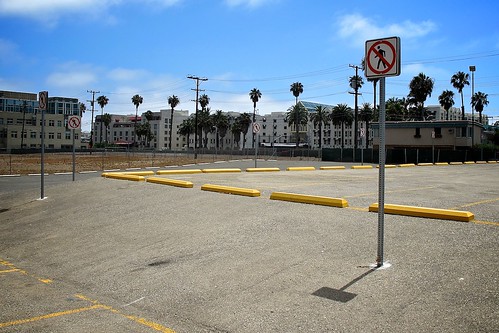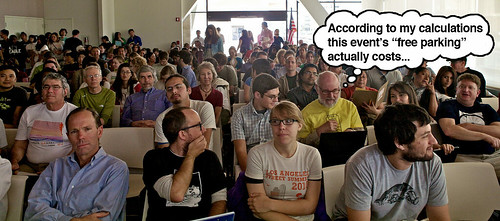
Ever since I attended a lecture by Donald Shoup at the LA Street summit in 2010, it has been stuck in my brain that most municipal zoning codes effectively make it illegal for developers to pursue truly sustainable models of development. Parking minimum requirements set a bar for levels of parking that must be built, often with arbitrary formulas based on building use and size written during decades when trends of car use and ownership were on very different trajectories than they are today.
To make headway on environmental sustainability, and the lack of affordable housing in Santa Monica, both significant issues in recent Santa Monica politics, I believe it is time to give up on rigid parking minimums.
On the sustainability front, the present scale of automobile dependency in America is not enduring; as fuel becomes more costly and automobile infrastructure investments that expand capacity produce diminishing returns. Given all this, buildings with very low, or zero parking spaces for cars are more sustainable than those with large surface lots of deep garages, regardless if a LEED certification is stamped on it or not. However such car-lite development and land use is outlawed in most areas of Santa Monica, and really most of America.
In the realm of housing, as I pointed out in the post concerning the new affordable housing building going up on Pico Boulevard, high levels of parking for cars adds to construction cost and diminishes the number of units that can be provided for housing people. Developers and managers bundle the cost of parking with units, causing higher rent for anyone living in the development regardless of whether they own a car (or two) or not.
In the case of non-profit developers, fewer units will be constructed to make way for parking. Many of the most affordable market rate apartments in the city could never be built now, because they have too few parking spaces. My own building would not be built if proposed today. Only a few units of our small complex have parking garages.
Such codes can be circumvented to some extent in Santa Monica through the request of a zoning variance. Applying for a variance triggers a costly and time consuming public process with no guarantee of earning a variance. For the big developers, passing through such hoops is an annoyance but one they will go through with a team of experts to navigate the process.
For smaller developers, businesses and land owners, seeking a zoning variance to allow fewer parking spaces is a hassle most avoid; even if building fewer parking spaces could benefit their bottom line, provide cheaper retail space for business, or more access to housing.
Take for instance this small 8 unit half finished apartment building, started in 1997 in Santa Monica and featured recently in the Lookout News. The development languishes with a tight budget, a difficult permitting process that changed during construction, and impractical codes for the site foot print. In 2010 some exceptions were made for senior housing. This project is now "senior housing" in order to get a parking requirement reduction.
"But while the battle with the contractor has been a major cause of delays, the biggest problem has been parking, according to Desai. A four-unit apartment requires eight parking places for tenants and at least one for guests, he said.
“There isn't any room,” he said. To meet the standards, Desai said he would have had to demolish the building and start from scratch, which he simply couldn't afford."
During the Donald Shoup lecture that I attended, he made quite a few suggestions for various parking policy changes. Some are simple to implement. Others are more complex. If there is only one change you can make in your community, take all the automobile parking minimum requirements and flip them into maximums. From there on out the market would be allowed to experiment with catering to reduced automobile use whereas presently most municipalities force of law to compel builders to cater to automobile centric lifestyles.
Such a change would not be immediately dramatic or disruptive. Most developers do not build more parking than the minimums require. Because developers are often looking for conservative investments, they would also be apprehensive to provide too few parking spaces to be viable because they need willing tenants. Without parking minimums, developers could at least be allowed to test the market for car-free or car-lite tenants and clientele in markets outside the expensive downtown core, where new buildings currently can be built without their own parking.
The city of Santa Monica is in the process of overhauling it’s zoning code soon, one aspect of implementing the updated LUCE general plan. Now is the perfect opportunity to rethink zoning policies crafted decades ago and that no longer reflect the new economic reality and shifting demographics of our time. If Santa Monica wants to really be as progressive and cutting edge as it likes to think it is, parking minimums ought to go and I have a new slogan to toss into this zoning ordinance update debate, “Building for people without cars is not a crime.” That might make a good t-shirt.
If you want to get involved, the city is hosting a public open house on zoning at the Civic Auditorium East Wing, at 6:00pm on Monday May 14th. The city has also has a few online channels for interacting and getting updates about the zoning update process, including the city website, a twitter account and a facebook page.








